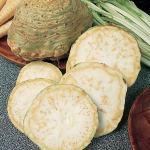Categories
Calendars
Guides
Reviews
Archive
Gallery
Articles
Ask Our Gardening Expert
How to Grow Celeriac
Celeriac The flesh has a texture similar to that of
potatoes with a definite taste of celery. It's an easy to grow
vegetable with a long cropping time. Give it a try.
CELERIAC QUICK GUIDE Latin Name Type Site and Soil Plant to Harvest Time Yield
Soil and Site The best soil is one which retains moisture
but is also free-draining. Although those are the ideal conditions
celeriac is very tolerant of soil conditions and will grow well on
most sites. They prefer a site which is in full sun but will tolerate
part-shade very well. Recommended Variety
The skin is smooth and the flesh is mottled white. This
is a vigorous growing celeriac with firm, large roots. This variety is available from Suttons,
click here for more information. Sowing Celeriac
Celeriac takes longer than most vegetables to reach maturity and
it also requires a soil temperature of at least 59�F if the seeds
are to germinate. If you live in a warm climate which has the
correct soil temperature then the seed can be sown directly
into the soil in early March and they will grow well. Sow thinly at a depth of about �cm / �in. As
the seedlings emerge, gradually thin the seedlings to about 30cm (1ft) apart in
rows which are 35cm (14in) apart.
In cooler areas, sow indoors or
in a greenhouse / cold frame. Sow two seeds to a small pot (7.5cm /
3in) in early March.
When the seedlings emerge, thin out the weakest growing one. The
plants can be transplanted to their final positions in
mid-May
when the
danger of frost is minimal. Acclimatise the plants to the outside
conditions for a week or two before planting outside.
Celeriac is related to the more common celery but is only now
being widely grown outside of Germany.
Apium graveolens rapaceum
Cultivated as an annual, it is a hardy
biennial
Full sun or part shade in a soil manured the previous
year.
24 weeks.
3 plants per metre (3 foot)
Celeriac has been bred from wild celery which originates from
Northern Europe. They grow best in a soil which has been fertilised the
previous season and not the current season. Too much nitrogen in the
soil from manure etc. will encourage leaf growth rather then growth
of the bulbous root.
 The variety "Monarch" has been awarded a RHS Award of Garden
Merit.
The variety "Monarch" has been awarded a RHS Award of Garden
Merit.
Name: Michael Moroney
E-mail: mjjmoroney@gmail.com
Date posted: December 12, 2011 - 04:15 pm
Message: I can grow wonderful crops of celeriac leaves but regretably no bulb underneath. Please advise as to what I might be doing wronl
Name: West A.
E-mail: nanddwest@talktalk.net
Date posted: August 12, 2011 - 03:20 pm
Message: I have tried twice to give my extremely successful method of growing celeriac fom seed top finished crop and each time my work is eliminated when near completion. I thought you wanted grower's experiences and advice but this doesn't appear to be possible to give. Having written at length twice and failed I quit
Name: West A.
E-mail: nanddwest@talktalk.net
Date posted: August 12, 2011 - 03:19 pm
Message: I have tried twice to give my extremely successful method of growing celeriac fom seed top finished crop and each time my work is eliminated when near completion. I thought you wanted grower's experiences and advice but this doesn't appear to be possible to give. Having written at length twice and failed I quit
Name: Christel Webb
E-mail: christel.webb@gmail.com
Date posted: December 28, 2010 - 01:53 pm
Message: We live in New Zealand so everything is upside down here. Our celeriac should not be ready for harvest until march but it is blooming since about 4 weeks. Does that mean it is no good anymore?
Kind regards
Christel Webb NZ